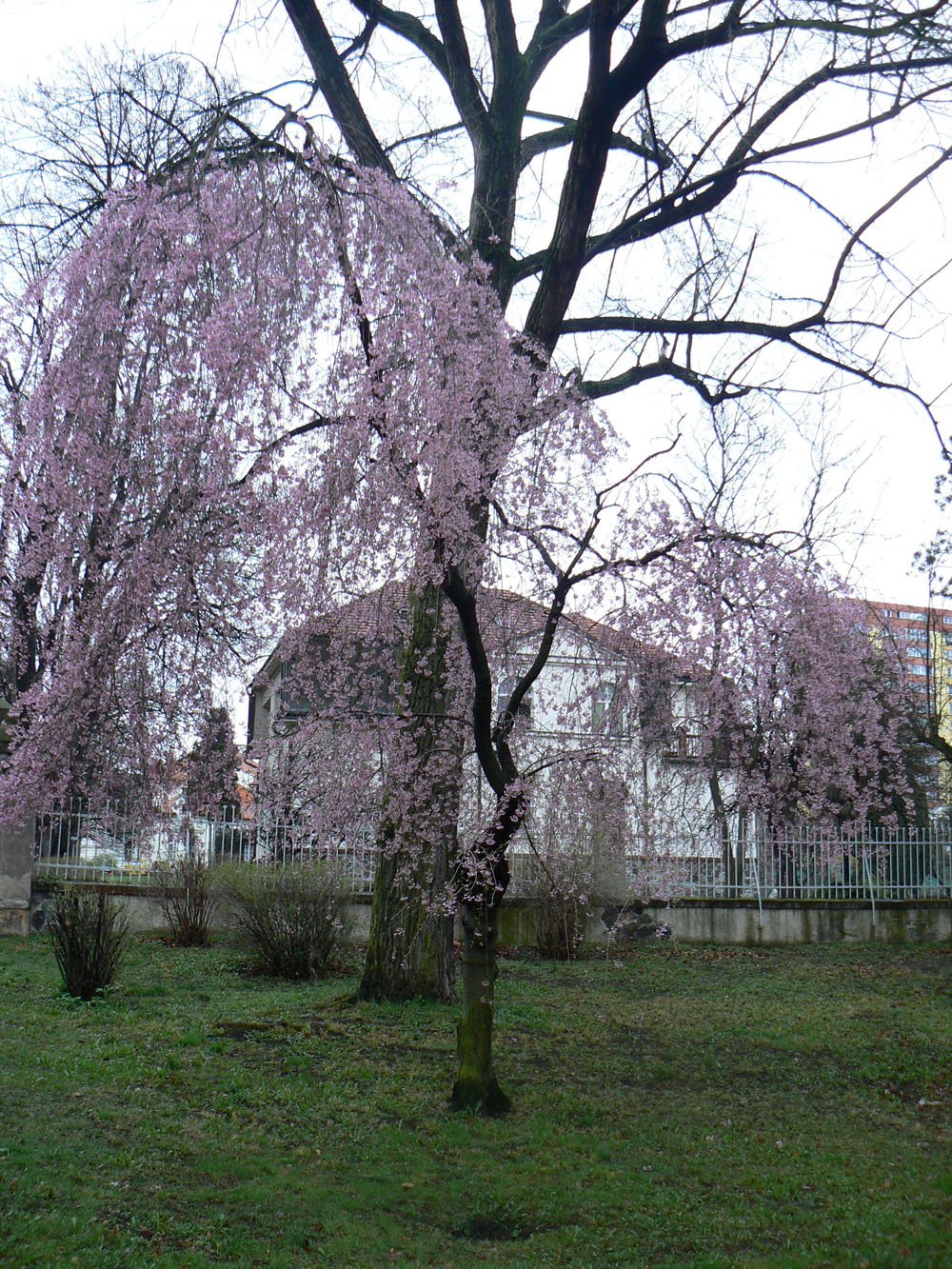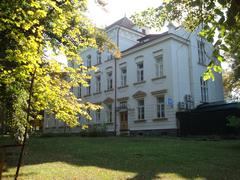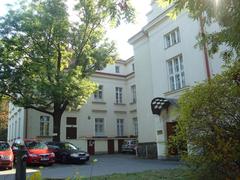
Psychiatrická Nemocnice Bohnice: Visiting Hours, Tickets, and Complete Guide to Prague’s Historic Psychiatric Hospital
Date: 15/06/2025
Introduction
Psychiatrická Nemocnice Bohnice, located in Prague’s northern district, stands as one of Central Europe’s largest and most historically significant psychiatric hospitals. Since its establishment in the early 20th century, Bohnice has evolved from a model of humane psychiatric care to a vibrant cultural and historical landmark. Visitors today can explore its unique pavilion-style architecture, tranquil parklands, poignant abandoned cemetery, and participate in acclaimed cultural events like the “Mezi ploty” festival. Whether you are interested in medical history, architecture, or social change, Bohnice offers a multifaceted experience within the Czech capital.
This guide provides a detailed overview of Bohnice’s history, architectural highlights, current role in mental health care, and everything you need to plan your visit—including updated information on visiting hours, ticketing, accessibility, travel tips, and nearby attractions. For further reading and resources, refer to trusted sources such as Český rozhlas, Prague Now, and Travel Buddies.
Table of Contents
- History and Development
- Architectural Heritage
- Evolution Through the 20th and 21st Centuries
- Bohnice’s Role in Czech Mental Health Care
- Preservation and Modern-Day Significance
- Visiting Information
- Getting There and Nearby Attractions
- Visuals and Media
- Frequently Asked Questions (FAQ)
- Conclusion and Visitor Summary
- Sources
History and Development
Founding and Early Years
Psychiatrická Nemocnice Bohnice was conceived during a period of rapid industrialization in the late 19th and early 20th centuries, when Prague’s existing mental health facilities were overburdened. In 1903, the Provincial Committee approved plans to build a modern psychiatric hospital in Bohnice, then a rural area north of Prague (iRozhlas). The site, spanning over 300 hectares, was purchased in 1906, and construction began soon after.
By 1912, Bohnice opened with 28 treatment pavilions, a farm, cemetery, and infrastructure designed for approximately 1,900 patients. This “village” arrangement reflected a new philosophy—moving away from fortress-like asylums to environments that fostered dignity and healing (Český rozhlas).
Architectural Heritage
Renowned Czech architect Václav Roštlapil designed Bohnice with a focus on humane treatment and integration with nature. The hospital’s pavilion-style layout, set within an English-style park, promotes openness and tranquility. The complex features the iconic Art Nouveau Church of St. Wenceslas, which stands as a symbol of the restorative power of beauty and spirituality (Prague Now).
The entire site is protected as a cultural monument, and its historic buildings and green spaces are open to visitors interested in medical history and architecture.
Evolution Through the 20th and 21st Centuries
Interwar and WWII Periods:
Bohnice expanded during the interwar years, at times treating up to 2,500 patients. The institution weathered both World Wars, maintaining its reputation for progressive psychiatric care (iRozhlas).
Communist Era (1948–1989):
Under centralized rule, Bohnice faced challenges common to Eastern Bloc psychiatric care, including custodial approaches and limited modernization. The church was repurposed for storage, and community ties weakened, though occupational therapy and communal activities persisted (English Radio; Cambridge University Press).
Post-Communist Transformation:
After 1989, Bohnice pioneered patient-centered reforms, expanding outpatient and community-based services, introducing a 24-hour helpline, and developing partnerships with NGOs. Recent reforms emphasize deinstitutionalization, creative therapy, and social integration (Cambridge University Press; English Radio).
Bohnice’s Role in Czech Mental Health Care
Bohnice has symbolized the shift from custodial institutions to compassionate, community-integrated care. The hospital plays a key role in public mental health awareness, hosting the renowned “Mezi ploty” festival and other cultural programs that foster dialogue and destigmatization (Český rozhlas; MyHospitalNow).
Preservation and Modern-Day Significance
Today, Bohnice is recognized as a National Cultural Monument. Its historic pavilions, lush parkland, and Art Nouveau church attract both locals and tourists. The poignant “Hřbitov bláznů” (Cemetery of the Insane) highlights evolving attitudes toward mental health and memorializes marginalized patients (PowerTraveller).
Bohnice also integrates cultural activities, including theater, art exhibitions, and social enterprises, creating a welcoming environment for visitors and the community.
Visiting Information
Visiting Hours and Tickets
- Park and Grounds: Open daily, typically from 8:00 AM to 8:00 PM. Entry to public outdoor areas is free (Bohnice Hospital).
- Guided Tours: Available on weekends and during special events, usually by prior arrangement. Standard tour times are between 10:00 AM and 4:00 PM; tours last 1.5–3 hours (Musement).
- Tickets: Required for guided tours and festivals. Prices range from 300–400 CZK per person; discounts are available for students and seniors. Advance booking is recommended (Travel Buddies).
Accessibility
- The main paths are wheelchair accessible; some areas, such as the abandoned cemetery, may be uneven.
- Notify the hospital or tour provider in advance for special accommodations.
Visitor Tips
- Wear comfortable shoes for extensive walking.
- Respect patient privacy; photography is allowed in public outdoor areas but not inside treatment buildings.
- Check the hospital’s official website for up-to-date event and tour schedules.
- Attend cultural events like the Mezi ploty festival for an immersive experience.
Getting There and Nearby Attractions
- Address: Ústavní 91/7, 181 00 Praha 8
- Public Transport:
- Metro Line C to Kobylisy, then bus 177 or 200 to “Katovická” stop; short walk to the main entrance.
- Tram lines 8 or 10 to stops near Bohnice.
- Taxi/Ride-share: 10–15 minutes from central Prague, approx. 330 CZK.
Nearby Attractions:
- Bohnice Animal Cemetery: A unique and tranquil site.
- Čimický háj Forest: Offers scenic walking trails.
- Prague Zoo: Located about 4 km away.
Visuals and Media
Enhance your visit by reviewing virtual tours and images of the hospital’s key landmarks:
- St. Wenceslas Church
- Historic pavilions
- Abandoned cemetery
- Mezi ploty festival scenes
Use alt tags such as “Bohnice psychiatric hospital visiting hours” and “Prague historical sites” when sharing images.
Frequently Asked Questions (FAQ)
Q: Can I visit Bohnice Psychiatric Hospital’s grounds?
A: Yes, the park and public areas are open daily. Clinical buildings are closed to the public.
Q: Are guided tours available?
A: Yes, several organizations provide guided tours, especially on weekends and during events. Advance booking is advised.
Q: Is there an entrance fee?
A: Entry to outdoor public areas is free. Guided tours and events require tickets.
Q: Is the hospital wheelchair accessible?
A: Main paths are accessible; some sites may have uneven terrain. Contact the provider for specific needs.
Q: Are children allowed?
A: Some tours, especially those covering sensitive topics, are best for adults and older teens.
Conclusion and Visitor Summary
Psychiatrická Nemocnice Bohnice is far more than a psychiatric hospital—it is a living chronicle of Prague’s social, medical, and architectural evolution. Its spacious grounds offer a peaceful retreat, while its history and cultural initiatives invite reflection on changing attitudes toward mental health. Guided tours, festivals, and public art events welcome all, helping to destigmatize mental illness and foster community engagement.
Visitor Tips Recap:
- Check visiting hours and book tours in advance.
- Respect privacy and hospital regulations.
- Combine your visit with nearby attractions for a full day’s experience.
- Consult official resources for the latest updates.
For detailed planning, visit the official hospital website, and consult trusted guides like Český rozhlas, Prague Now, and Travel Buddies.
Sources
- Český rozhlas
- Travel Buddies
- Prague Now
- Cambridge University Press
- English Radio Prague
- Bohnice Hospital
- Musement
























































































































































































